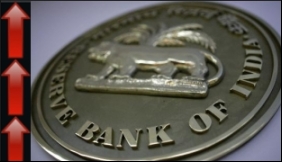|

|
SMEs to suffer most after RBI's key rate hike
|
|

|
|
| Top Stories |
 |
|
|
|
Writuparna Kakati | 26 Jun, 2008
Finally, the RBI has increased two key policy rates - the repo rate and the CRR. It is not an unexpected move; after the country's inflation rate reached a 13-year high of 11.05%, economists warned that the RBI might increase its key interest rates as the central bank did earlier this month.
Industry lobbies from all over the country have criticised the move citing that Indian industry has been subjected to successive rate hikes over the last one and a half years. What further worsens the situation this time is that the industries, in these days, facing a lot of problems like rising raw material costs, rising fuel prices, increased cargo rate, acute international competition, and so on. A rise in bank interest rates will affect industry's domestic expansion plans, especially that of SMEs and MSMEs as they depend mainly upon bank loans for financial requirements.
The intensity of the recent repo and CRR rate hike by the RBI is much more than it was expected. The RBI hiked the repo rate from 8% to 8.50% with immediate effect. The central bank also increased the CRR of banks by 50 basis points to 8.75 percent in two stages keeping in view "domestic and global macroeconomic and financial developments". From July 5, the CRR will be set at 8.50% and from July 19 at 8.75%.
This is the second time in less than a fortnight that the RBI has raised the repo rate to contain inflation. Earlier this month 911th June) the RBI increased the repo rate from 7.75% to 8% - a move which took everyone by surprise as the RBI had refrained from raising benchmark rates in its policy meet in April 2008. The RBI termed this aggressive move, which came exactly a week after domestic fuel prices were raised and the country's inflation reached 8.75 percent for the week ended May 31 against 8.24 percent for the week before, as part of its attempts to contain rising inflation.
But despite all the preventive measures by the RBI and the government, India's annual inflation rate touched a 13-year high of 11.05 percent (for the week ended June 7) leaving the whole country- the policy makers, the business community, and the general public- all speechless. The Finance Minister confirmed, "The government is aware of difficulties... Naturally, we will have to look at stronger measures on demand and monetary sides...We will try to address to best of our abilities the demand and monetary sides and try to improve supply side also".
Although Chidambaram did not elaborate on the measures, economists and bankers warned that the government is very likely to consider further hikes in the repo rate and the cash reserve ratio (CRR), a move which could lead to increase in lending rates. A member of Prime Minister's Economic Advisory Council revealed , "There is lot of pressure on interest rates and the RBI may further tighten the monetary policy in order to anchor inflation to reasonable level".
Finally, all the speculations came to an end, and this time again with a surprise. Experts anticipated that the RBI might increase the repo rate or the CRR by a quarter percent before July policy review. But the RBI increased both the key rates, and both by 50 basis points. As a hike in repo rate will make it more expensive for banks to get money from RBI, it is most likely that the banks will have to charge customers a higher interest rate. As a result, customers will have to pay more interest rates for home loans, car loans and consumer loans. And needless to say, industries will suffer more and SMEs in the country most.
Now the question is 'how much the rate will go up and when?'. And what if India's inflation rises again! Policy makers must keep in mind that SMEs are affected most when bank interest rates are hiked. In our country, SMEs contribute roughly 40% to the country’s total domestic production, and close to 50% of total exports. Challenging inflation at the expense of their interest may prove fatal to the country's economy. There is no doubt that rising inflation is a serious concern but we must look for better ways to check it. Recent inflation rise is mainly global supply led, and therefore, it requires action at the global level to deal with the current phase of price pressure.
|
|
|
| |
|
|
|
|
|
|
|
|
|
|
|
|
|
|
| |
| Customs Exchange Rates |
| Currency |
Import |
Export |
US Dollar
|
84.35
|
82.60 |
UK Pound
|
106.35
|
102.90 |
Euro
|
92.50
|
89.35 |
| Japanese
Yen |
55.05 |
53.40 |
| As on 12 Oct, 2024 |
|
|
| Daily Poll |
 |
 |
| Do you think Indian businesses will be negatively affected by Trump's America First Policy? |
|
|
|
|
|
| Commented Stories |
 |
|
|
|
|
|
| |
|